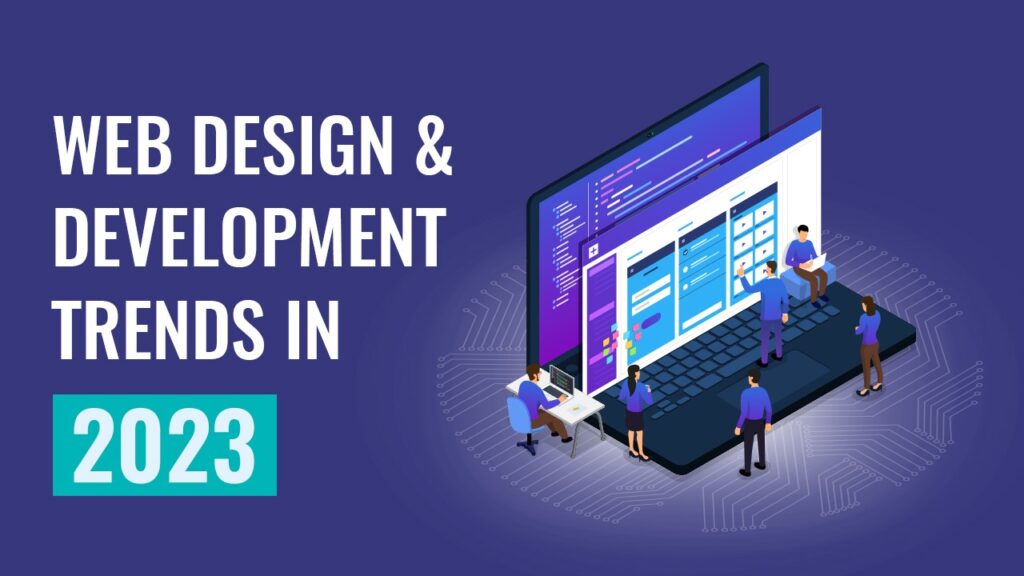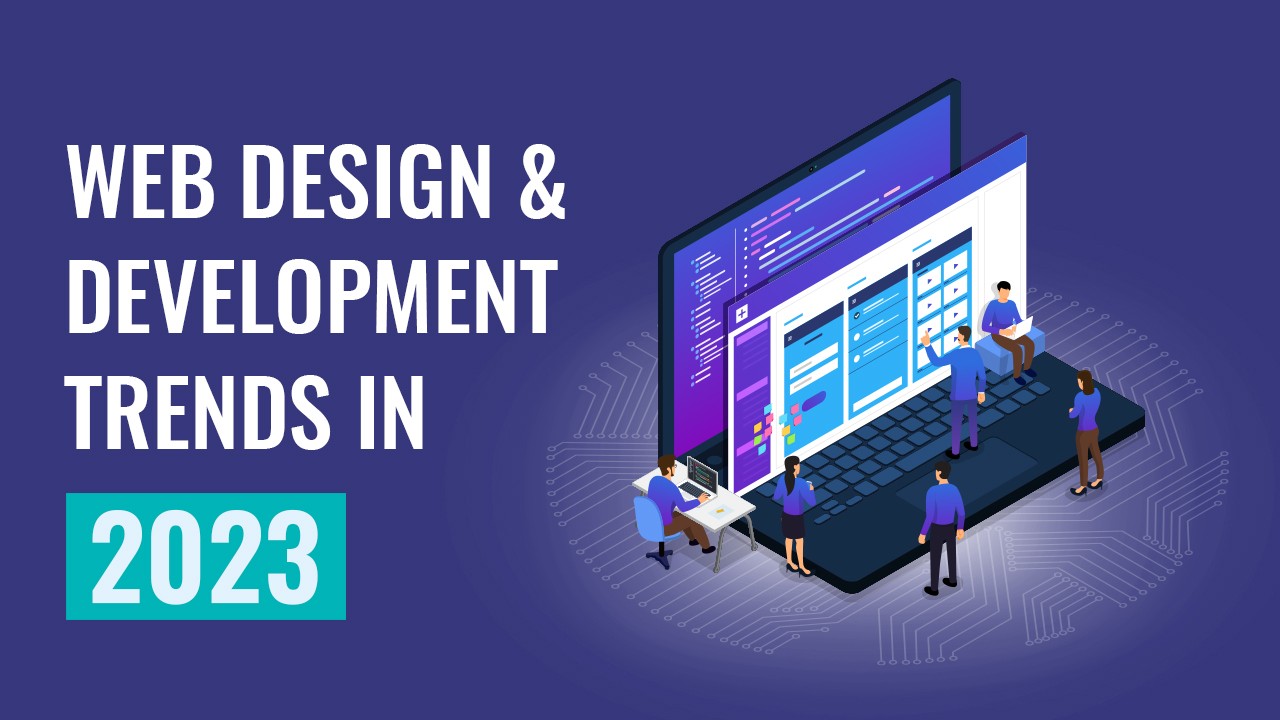In the rapidly evolving world of web design and development, staying up to date with the latest trends is crucial for businesses and individuals seeking an impactful online presence. In 2023, several trends are expected to shape the web design and development landscape. From responsive web design to the integration of AI, these trends will redefine the way websites are created and experienced. This article explores the top web design and development trends for 2023, highlighting their importance and potential benefits.

Web Design and Development
1. Responsive Web Design
1.1 Importance of Responsive Design
In an era where mobile devices dominate internet usage, responsive web design has become essential. With varying screen sizes and resolutions, websites must adapt seamlessly to provide optimal user experiences across all devices. Responsive design ensures that websites are visually appealing and functional on desktops, tablets, and smartphones.
1.2 Mobile-First Approach
A mobile-first approach involves designing websites primarily for mobile devices and then scaling up for larger screens. This strategy recognizes the growing significance of mobile browsing and ensures that websites are optimized for mobile users. By prioritizing mobile experiences, businesses can effectively engage their audience and improve conversion rates.
2. Dark Mode Design
2.1 Benefits of Dark Mode
Dark mode has gained immense popularity due to its aesthetic appeal and potential energy-saving benefits. Dark-themed interfaces not only provide a visually striking experience but also reduce eye strain, particularly in low-light environments. By offering dark mode as an option, websites can cater to users’ preferences and enhance accessibility.
2.2 Accessibility Considerations
While dark mode design offers numerous advantages, it’s crucial to consider accessibility. Some users may find it challenging to read light-colored text on dark backgrounds. Implementing appropriate contrast ratios and providing alternative color options can ensure inclusivity and make dark mode accessible to a wider audience.
3. Microinteractions
3.1 Enhancing User Experience
Microinteractions refer to subtle animations and feedback that occur within a website. These small, interactive elements provide users with visual cues and improve the overall user experience. Whether it’s a button animation or a loading indicator, micro-interactions add a layer of delight and engagement to websites, making them more memorable.
3.2 Attention to Detail
Web designers are increasingly focusing on small details that make a significant impact. By paying attention to micro-interactions, designers can create intuitive and delightful experiences for users. From hover effects to progress indicators, these details contribute to the overall polish and professionalism of a website.
4. Minimalistic Design
4.1 Simplifying User Interface
The minimalistic design aims to eliminate unnecessary elements and provide a clean and clutter-free user interface. By embracing simplicity, websites can enhance user focus and guide visitors toward their intended actions. The minimalistic design emphasizes essential content and creates a sense of elegance and sophistication.
4.2 Focus on Content
In a world inundated with information, content is king. The minimalistic design allows content to take center stage, ensuring that the message or product is effectively communicated to users. By removing distractions and employing clear typography, websites can engage visitors and deliver their intended message more effectively.
5. Voice User Interface
5.1 Voice-Activated Commands
With the rise of voice assistants and smart devices, voice user interfaces (VUI) are becoming increasingly prevalent. Integrating voice-activated commands into websites enables hands-free interactions and offers convenience to users. By leveraging speech recognition technology, businesses can create seamless and efficient user experiences.
5.2 Improving Accessibility
Voice user interfaces have the potential to revolutionize accessibility for individuals with disabilities. By providing voice-driven alternatives to traditional input methods, websites can ensure inclusivity and allow users with limited mobility or visual impairments to navigate and interact with digital content effortlessly.
6. Augmented Reality (AR)
6.1 Enhancing User Engagement
Augmented reality (AR) is poised to revolutionize the way users interact with websites. By overlaying virtual elements onto the real world, AR creates immersive and interactive experiences. From virtual showrooms to try-on features, AR technology enables businesses to engage customers in unique and compelling ways.
6.2 Virtual Try-On Experiences
In industries like fashion and home decor, AR-powered virtual try-on experiences have gained traction. By allowing users to visualize products in their own space or try on virtual clothing, businesses can bridge the gap between the physical and digital realms. Virtual try-on enhance customer confidence and reduce the need for returns, benefiting both businesses and consumers.
7. Progressive Web Apps (PWAs)
7.1 Cross-Platform Compatibility
Progressive web apps (PWAs) combine the best of web and mobile applications, offering a seamless user experience across various platforms. PWAs are responsive, installable, and capable of working offline, providing users with app-like experiences directly from their browsers. With their cross-platform compatibility, PWAs eliminate the need for separate native applications for different operating systems.
7.2 Enhanced Performance
PWAs are known for their exceptional performance. They load quickly, respond swiftly to user interactions, and offer offline capabilities. By leveraging service workers and caching strategies, PWAs provide a smooth and reliable user experience, even in low-connectivity environments. The enhanced performance of PWAs contributes to increased user engagement and conversion rates.
8. Chatbots and AI
8.1 Improving Customer Support
Chatbots powered by artificial intelligence (AI) have transformed customer support by providing instant assistance and personalized interactions. AI-driven chatbots can handle routine inquiries, offer product recommendations, and simulate human-like conversations. By incorporating chatbots into websites, businesses can provide 24/7 support, reduce response times, and enhance customer satisfaction.
8.2 Personalized User Experience
AI technologies enable websites to deliver personalized user experiences based on user behavior, preferences, and past interactions. By analyzing data and patterns, AI can tailor content, recommendations, and offers to individual users, fostering deeper engagement and driving conversions. Personalized experiences create a sense of exclusivity and relevance, strengthening the bond between businesses and their customers.
9. Motion Design
9.1 Adding Visual Interest
Motion design involves incorporating animated elements into websites to create visually engaging experiences. From subtle transitions to dynamic illustrations, motion design adds a layer of interactivity and captivates users’ attention. Carefully implemented motion design not only makes websites more visually appealing but also guides users’ focus and conveys information effectively.
9.2 Storytelling through Animation
Motion design offers a powerful medium for storytelling. By using animations and visual narratives, websites can communicate complex concepts, evoke emotions, and create memorable experiences. From animated infographics to interactive storytelling, animation allows businesses to engage users in a compelling and interactive manner.
Conclusion
As we step into 2023, the world of web design and development is set to embrace exciting trends that enhance user experiences, improve accessibility, and drive business growth. From responsive design to voice user interfaces, these trends highlight the industry’s focus on user-centricity, simplicity, and innovation. By incorporating these trends into their web design strategies, businesses can stay ahead of the competition and create impactful online experiences for their audience.
Why is responsive web design important?
Responsive web design ensures that websites adapt to different screen sizes and devices, providing optimal user experiences across desktops, tablets, and smartphones.
What are the benefits of dark mode design?
Dark mode design offers aesthetic appeal, reduces eye strain in low-light environments, and can potentially save energy on devices with OLED screens.
How do micro interactions enhance the user experience?
Microinteractions provide subtle animations and feedback within a website, improving user experience by adding visual cues and making interactions more engaging.
What is a mobile-first approach to web design?
A mobile-first approach involves designing websites primarily for mobile devices and then scaling up for larger screens, acknowledging the significance of mobile browsing.
How can augmented reality enhance user engagement?
Augmented reality overlays virtual elements onto the real world, creating immersive and interactive experiences that allow users to visualize products or try them on virtually.
What are progressive web apps (PWAs)?
Progressive web apps combine the best features of web and mobile applications, offering cross-platform compatibility, offline capabilities, and app-like experiences directly from web browsers.
